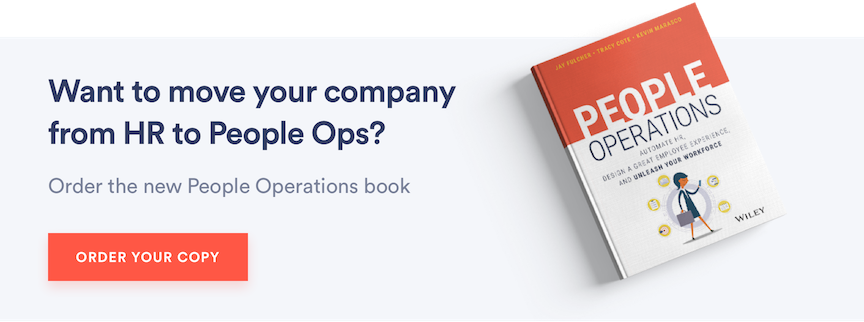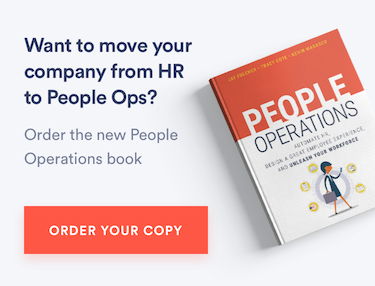
Subscribe on:
Q&A: What should I be doing to train, develop, and grow leaders in my organization?
It’s no secret. If you want to build a great company, you must start by investing in your people. Without this proactive approach, it’s hard to grow. In this episode, Morgan Furchner, Associate Product Marketing Manager at TriNet Zenefits, shares how you can help train, develop, and grow leaders to push your business to the […]
It’s no secret. If you want to build a great company, you must start by investing in your people. Without this proactive approach, it’s hard to grow.
In this episode, Morgan Furchner, Associate Product Marketing Manager at TriNet Zenefits, shares how you can help train, develop, and grow leaders to push your business to the next level.
Additional Resources:
- Order your copy of our book People Operations: Zenefits.com/pops-book

On this episode, you’ll hear:
- [00:28] Invest in your people to grow your organization
- [00:50] What happens when employees don’t get training
- [01:34] Treat the employee experience like the customer experience
- [02:44] The power of building relationships
- [03:15] Establish what’s in it for them
Transcript
Welcome to pops, the show that shows you how to shift from human resources, paperwork to people operations for the new world of work. How by answering one question at a time. I’m Morgan Furchner, associate product marketing manager at TriNet Zenefits here to help answer the question, what should I be doing to train, develop, and grow leaders in my organization?
It’s no secret. If you wanna build a great company, you must start by investing in your people. Optimize your organization for workforce productivity and results like revenue and profits rather than expense and efficiency, like time and cost. When employees don’t receive proper leadership development, it can leave them feeling unprepared to confidently step into higher roles such as manage.
And in no time, you could see decreased productivity, low team morale, a reduction in employee retention and other issues may arise. That’s why it’s essential to understand how to provide leadership development within your organization to cultivate the next generation of leaders. Getting started. Now, we’ll set you up for success.
So today I’ll be sharing three effective ways to train, develop, and grow leaders. One, begin leadership development early on. Two, create coaching opportunities and three, share your organization’s vision and strategy. Let’s take a deeper dive into each. Shall we
treat the employee experience, like the customer experience, optimizing it to create an advantage? No, it’s really never too early to start developing leaders. In fact, beginning leadership development should start as early as a recruiting process. Use an applicant tracking system to source top talent and scale your people, company and talent processes.
Weave leadership development throughout all levels of your people’s experience. An excellent way to help develop your leaders. Especially early on is to create mentor and coaching opportunities. There’s no better substitute for on-the-job experience and learning pair future leaders with already established and successful mentors in your organization that can coach them through challenging assignments.
Choose an effective mentor that sees this opportunity to support employee engagement by allowing their team members to explore new ways of working, rather than dictating how work needs to be completed. Allow your staff to learn from the experience rather than being told what to do. By holding conversation with your staff, mentors can analyze the effectiveness of the method that they.
Building these relationships early on improves confidence and it creates opportunities for open lines of communication throughout the entire leadership development process. Additionally, it deepens your future leaders understanding of the organization. Sharing your organization’s vision and strategy from a top level point of view also reinforces the development of leaders.
Connect the vision and strategy with the contributions made by the employee today and how their contributions will scale with them as they grow in the future. This is establishing the what’s in it for me element and making that connection will give your people a shared sense of mission, a sense of importance and encouragement to best align their priorities with your organiz.
Understanding the facets of an organization is crucial for future leaders. This transparency builds trust and it creates a culture of empowerment and value training. Developing and growing leaders in your organization builds a pipeline of potential that can weather unexpected vacancies and opportunities.
Take a proactive approach to prepare for future generations, crises, and the growth of your business by beginning leadership development early on, creating coaching opportunities and sharing your organization’s vision and strategy. Coupled with establishing the what’s in it for me element. With the right support and opportunities, a diversity of future leaders will emerge.
And ultimately help in shaping and optimizing your organization for years to come. 📍 Do you have a question for us? Click the link in the show notes. Or if you’ve got other ideas and feedback about our show, send them to podcasts benefits.com.
Previous Episodes
Q&A: Should we rehire someone who quit us?
Let the Robot Have Your Job
Q&A: I’m seeing turnover; what should I do?

About The People Ops Podcast
Every week, we share the decisions, struggles, and successes for keeping up with an evolving workforce and a changing workplace. No matter if you’ve been in HR or are just getting started, this combination of transformational stories with actionable ideas, as well as context on hot issues, keeps you up-to-date while answering the questions you didn’t even know you had.
Oh, and you know what they say about all work and no play? We tossed in a little levity to keep it real. Lessons, answers, and humor: everywhere you listen to podcasts.


Best-in-class remote teams will use best-in-class technology.
Zenefits mobile HR platform makes it easier to communicate with staff, onboarding new hires, pay employees, and manage any HR task from any home office.








